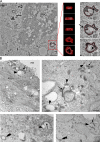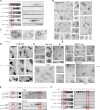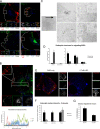Clathrin-independent carriers form a high capacity endocytic sorting system at the leading edge of migrating cells
- PMID: 20713605
- PMCID: PMC2928008
- DOI: 10.1083/jcb.201002119
Clathrin-independent carriers form a high capacity endocytic sorting system at the leading edge of migrating cells
Abstract
Although the importance of clathrin- and caveolin-independent endocytic pathways has recently emerged, key aspects of these routes remain unknown. Using quantitative ultrastructural approaches, we show that clathrin-independent carriers (CLICs) account for approximately three times the volume internalized by the clathrin-mediated endocytic pathway, forming the major pathway involved in uptake of fluid and bulk membrane in fibroblasts. Electron tomographic analysis of the 3D morphology of the earliest carriers shows that they are multidomain organelles that form a complex sorting station as they mature. Proteomic analysis provides direct links between CLICs, cellular adhesion turnover, and migration. Consistent with this, CLIC-mediated endocytosis of key cargo proteins, CD44 and Thy-1, is polarized at the leading edge of migrating fibroblasts, while transient ablation of CLICs impairs their ability to migrate. These studies provide the first quantitative ultrastructural analysis and molecular characterization of the major endocytic pathway in fibroblasts, a pathway that provides rapid membrane turnover at the leading edge of migrating cells.
Figures







References
-
- Bernatchez P.N., Acevedo L., Fernandez-Hernando C., Murata T., Chalouni C., Kim J., Erdjument-Bromage H., Shah V., Gratton J.P., McNally E.M., et al. 2007. Myoferlin regulates vascular endothelial growth factor receptor-2 stability and function. J. Biol. Chem. 282:30745–30753 10.1074/jbc.M704798200 - DOI - PubMed
-
- Bretscher A., Reczek D., Berryman M. 1997. Ezrin: a protein requiring conformational activation to link microfilaments to the plasma membrane in the assembly of cell surface structures. J. Cell Sci. 110:3011–3018 - PubMed
Publication types
MeSH terms
Substances
Grants and funding
LinkOut - more resources
Full Text Sources
Other Literature Sources
Miscellaneous

